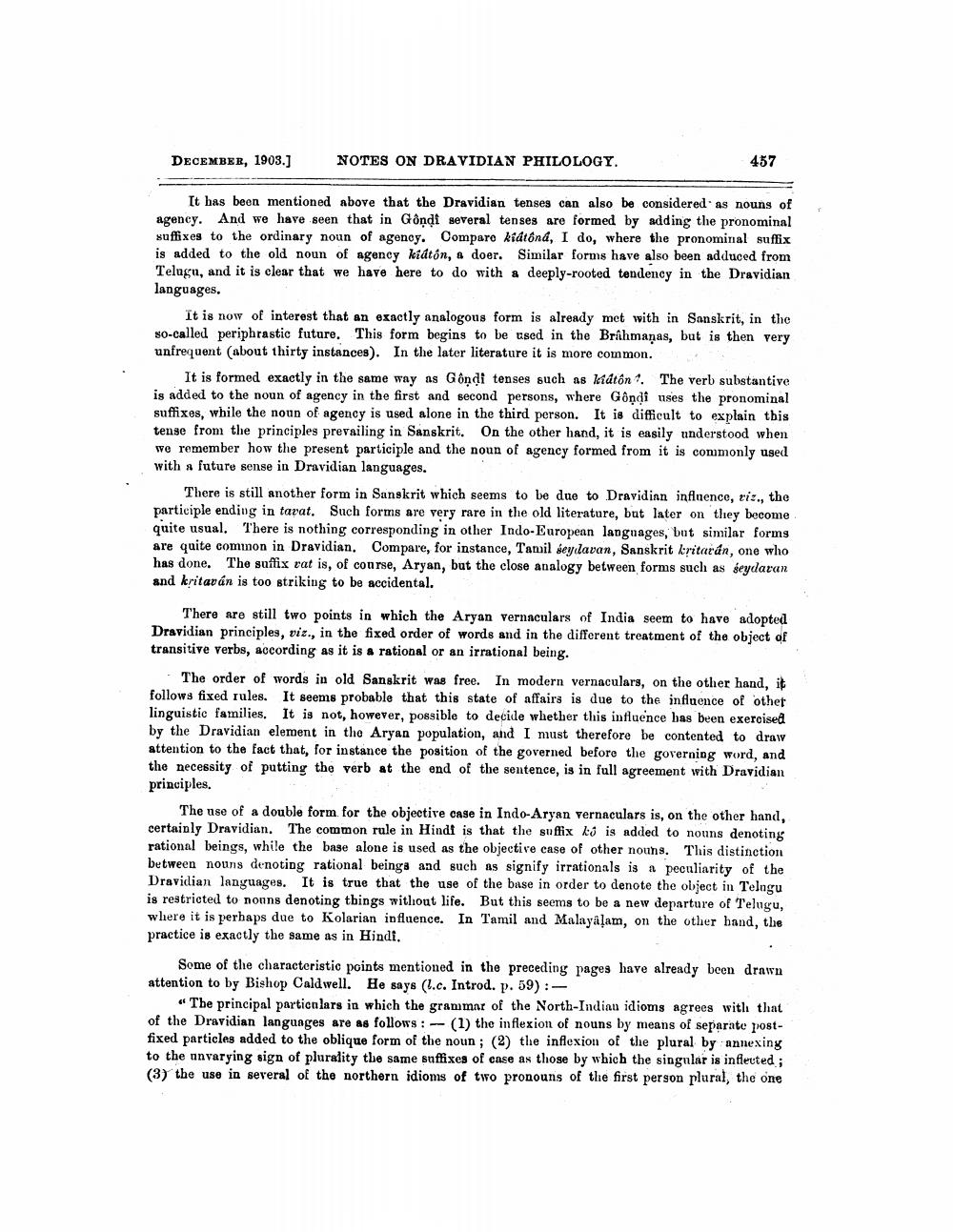________________
DECEMBER, 1903.]
NOTES ON DRAVIDIAN PHILOLOGY.
457
It has been mentioned above that the Dravidian tenses can also be considered as nouns of agency. And we have seen that in Gôndi several tenses are formed by adding the pronominal suffixes to the ordinary noun of agency. Compare kidtôná, I do, where the pronominal suffix is added to the old noun of agency kidtón, a doer. Similar forms have also been adduced from Telugu, and it is clear that we have here to do with a deeply-rooted tendency in the Dravidian languages.
It is now of interest that an exactly analogous form is already met with in Sanskrit, in the so-called periphrastic future. This form begins to be used in the Brahmanas, but is then very unfrequent (about thirty instances). In the later literature it is more common.
It is formed exactly in the same way as Gôndi tenses such as kidtôn. The verb substantive is added to the noun of agency in the first and second persons, where Gôndi uses the pronominal suffixes, while the noun of agency is used alone in the third person. It is difficult to explain this tense from the principles prevailing in Sanskrit. On the other hand, it is easily understood when we remember how the present participle and the noun of agency formed from it is commonly used with a future sense in Dravidian languages.
There is still another form in Sanskrit which seems to be due to Dravidian influence, riz., the participle ending in tavat. Such forms are very rare in the old literature, but later on they become quite usual. There is nothing corresponding in other Indo-European languages, but similar forms are quite common in Dravidian. Compare, for instance, Tamil seydlavan, Sanskrit kritarán, one who has done. The suffix rat is, of course, Aryan, but the close analogy between forms such as seydavan and kritaván is too striking to be accidental.
There are still two points in which the Aryan vernaculars of India seem to have adopted Dravidian principles, viz., in the fixed order of words and in the different treatment of the object of transitive verbs, according as it is a rational or an irrational being.
The order of words in old Sanskrit was free. In modern vernaculars, on the other hand, it follows fixed rules. It seems probable that this state of affairs is due to the influence of other linguistic families. It is not, however, possible to decide whether this influence has been exercised by the Dravidian element in the Aryan population, and I must therefore be contented to draw attention to the fact that, for instance the position of the governed before the governing word, and the necessity of putting the verb at the end of the sentence, is in full agreement with Dravidian principles.
The use of a double form for the objective case in Indo-Aryan vernaculars is, on the other hand, certainly Dravidian. The common rule in Hindi is that the suffix ko is added to nouns denoting rational beings, while the base alone is used as the objective case of other nouns. This distinction between nouns denoting rational beings and such as signify irrationals is a peculiarity of the Dravidian languages. It is true that the use of the base in order to denote the object in Telugu is restricted to nouns denoting things without life. But this seems to be a new departure of Telugu, where it is perhaps due to Kolarian influence. In Tamil and Malayalam, on the other hand, the practice is exactly the same as in Hindi.
Some of the characteristic points mentioned in the preceding pages have already been drawn attention to by Bishop Caldwell. He says (.c. Introd. p. 59):
"The principal particulars in which the grammar of the North-Indian idioms agrees with that of the Dravidian languages are as follows: (1) the inflexion of nouns by means of separate postfixed particles added to the oblique form of the noun; (2) the inflexion of the plural by annexing to the unvarying sign of plurality the same suffixes of case as those by which the singular is inflected; (3) the use in several of the northern idioms of two pronouns of the first person plural, the one
-




